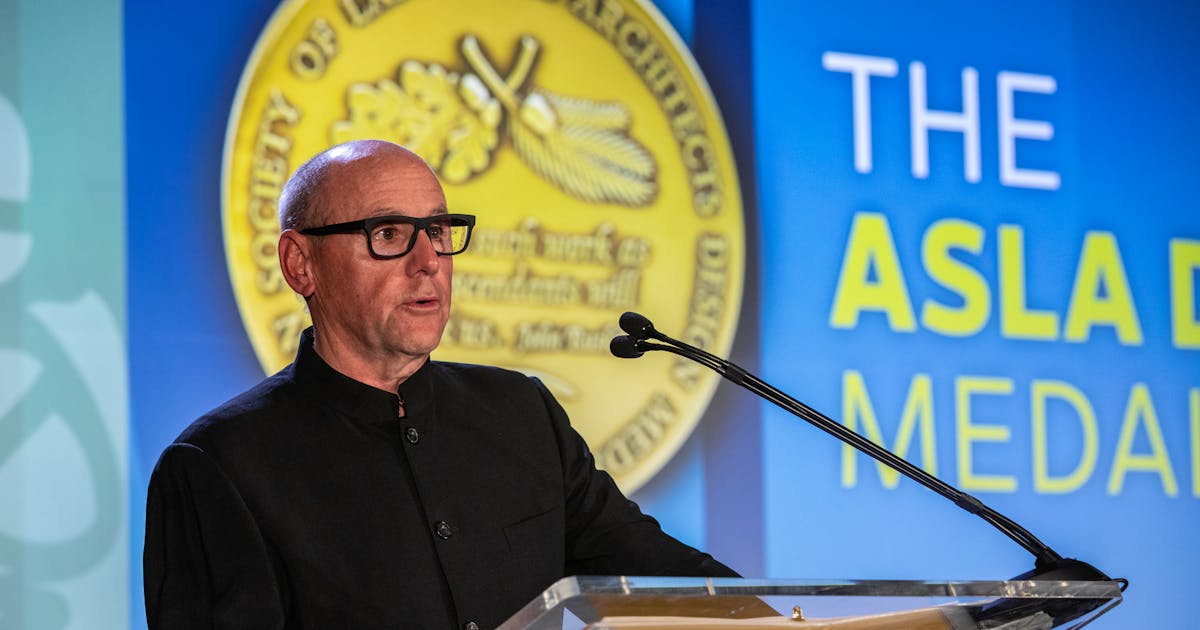
Six questions with landscape architect Tom Oslund
Twin Citians know and appreciate Tom Oslund’s work.
O2 Design, Oslund’s landscape architecture firm, designed Gold Medal Park, the 35W Bridge Remembrance Garden memorial and Target Plaza outside Target Field, all in Minneapolis, and is responsible for the 2017 renovation of the Minneapolis Sculpture Garden. In the suburbs, O2 Design, which Oslund founded in 1998, is the force behind corporate campuses for General Mills, Medtronic and Allianz Life USA.
That innovative, high-profile portfolio has captured the attention of his peers. Oslund was recently awarded the Design Medal from the American Society of Landscape Architects (ASLA). The prestigious honor recognizes “an individual landscape architect who has produced a body of exceptional design work at a sustained level for a period of at least ten years.”
In a recent phone conversation, the Minneapolis-raised and Harvard-educated Oslund discussed the award, the professional challenges of Minnesota’s climate and his favorite local landscapes.
Q: The roster of 18 previous winners has you in some very impressive company, including Martha Schwartz, Peter Walker, Michael Van Valkenburgh, M. Paul Friedberg and Lawrence Halprin. How did you find out about the award?
A: I got an e-mail from the current president of the ASLA that said that I’d won, and I can tell you, I was shocked. I thought, “They sent this to the wrong person.” It’s humbling to have received it. I’m the only one from the Midwest who has ever won, which I find really interesting.
The profession is pretty coastal. My colleagues from either coast would say, “Hey, why are you in Minneapolis?” And I would say, “You should come here, and you’ll see why we’re captivated by the landscape.” Minneapolis is such a unique city. It has obviously been going through a rough patch during the past couple of years. But there’s not another city that actually finished the vision of someone like Horace Cleveland — who worked in [Frederick Law] Olmsted’s office — of a park system in an urban location. For me, that’s what landscape architecture is all about — it’s making big impacts and being able to complete them over the course of time.
Q: Your work is often closely associated with a strong connection to art and artists. What’s the genesis of those collaborative relationships?
A: In a weird way, it started in graduate school. My first-semester instructors were Claes Oldenburg, Frank Gehry and Peter Walker. My approach to landscape architecture is definitely an outcome of my experience with and exposure to these people. Landscape architecture has always bounced between design and science, and that amazing experience set me on a trajectory of blurring those boundaries. I feel absolutely lucky and blessed to have had that experience. I’ve been teaching at various institutions over the years, and it’s really gratifying to pay that forward.
Q: What are the challenges of working within the framework of Minnesota’s climate? Does that kind of limitation force creativity?
A: Absolutely. I’ve always embraced that challenge, the minimal nature of what we can do within the environment. It’s much like the palette of a minimalist painter. We don’t have the breadth and depth of plant materials, but we’re blessed with some amazing natural materials: limestone, granite and such. We try to make as big an impact as we can with as few materials as possible. When we get to a place like Southern California, it’s like, “Oh, my word, we have so many choices!” We have to contain ourselves.
Q: What impact is climate change having on your work?
A: When I first came back from Boston we were in a climate plant zone that was challenging, at best. We’re now introducing plant materials in Minneapolis that we could grow in Boston, and that’s all due to climate change, to winters that are becoming more temperate. We’re also seeing varietals that have been cultivated for more hardiness. It has been a journey, and that’s why they call it “practice,” right? We keep learning, every year.
Q: Your firm is known for its public and corporate projects. Do you also work in the realm of private residences?
A: We haven’t done a lot, but the right clients have found us, and we’ve found them. Most have been collectors of art of some kind, and they were interested in beautiful, simple and powerful spaces. We tend to find these clients when they have a really difficult problem and they don’t know quite what to do. Putting a lawn on top of a 10-story building in downtown Minneapolis was a lot of fun. We’ve been really fortunate to have had clients like that.
Q: Are there Twin Cities landscapes — ones with no professional connections — that you admire?
A: Many. There’s a restored monoculture short-grass prairie in Wayzata that’s just beautiful; it’s like a Monet painting. And what [Horace] Cleveland did with the lakes in Minneapolis is mind-boggling to me. That landscape, at that scale, it’s just unbelievable. It’s hard to imagine Minneapolis without that system; it would be like New York without Central Park.
This conversation was edited and condensed for clarity.
